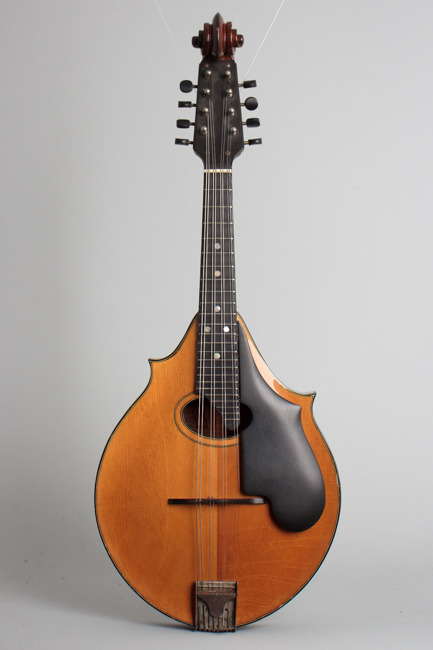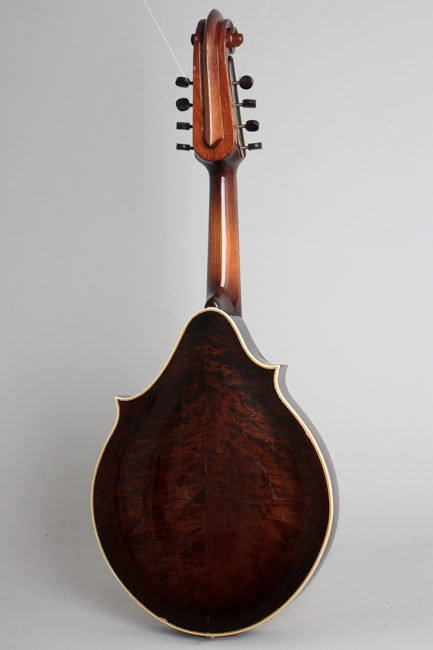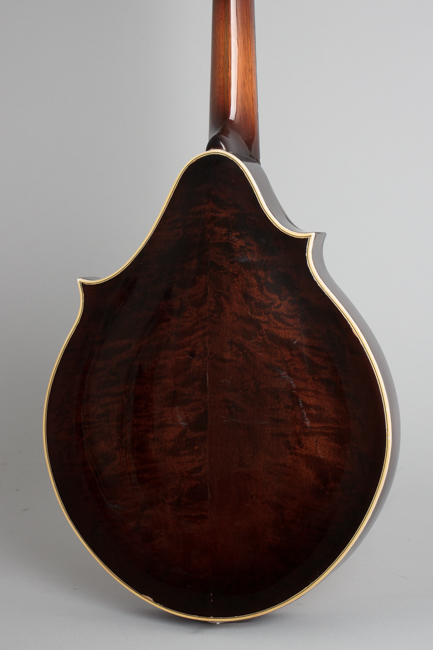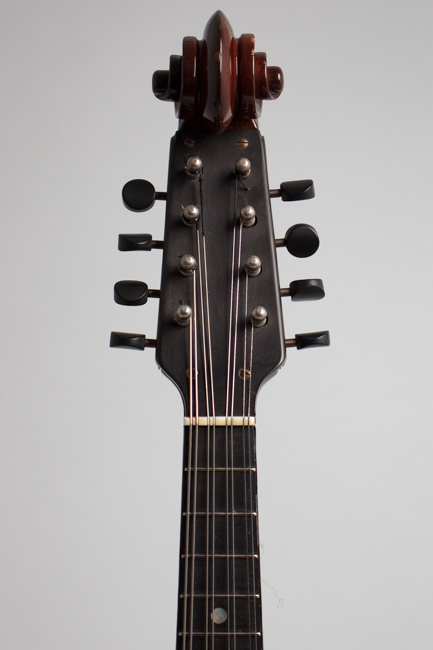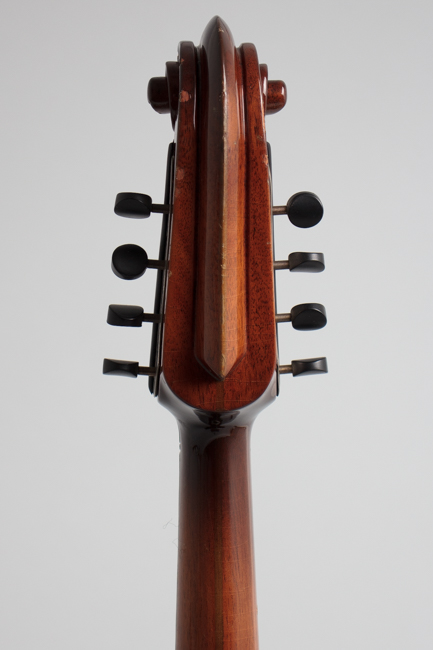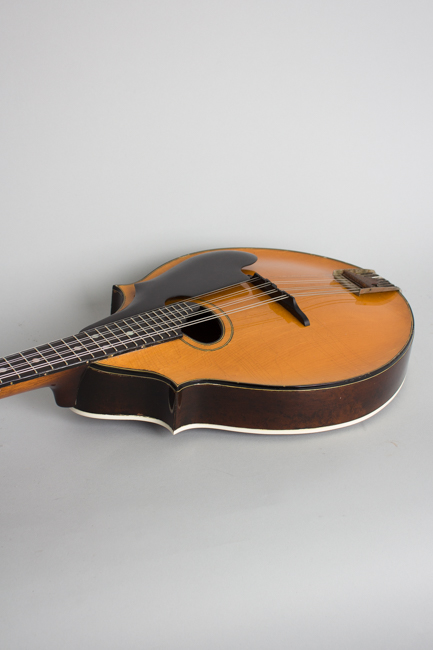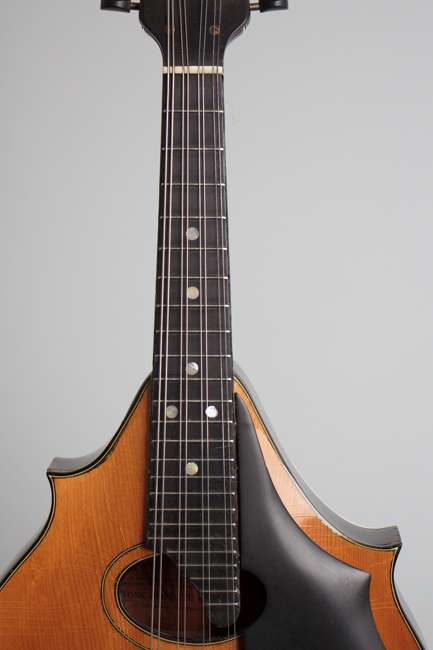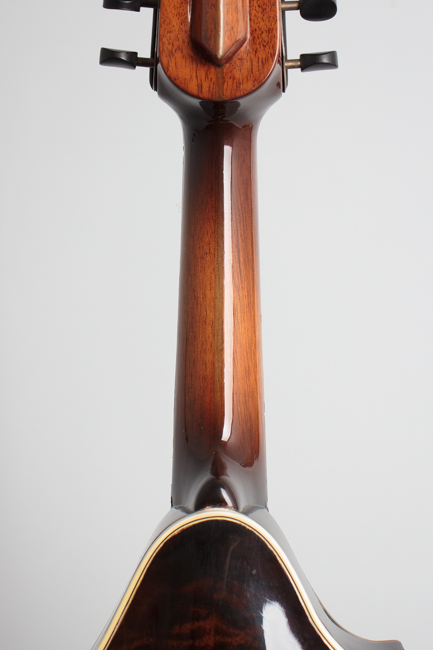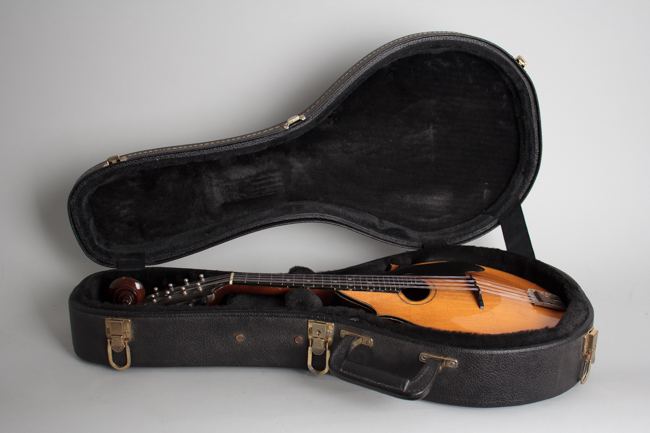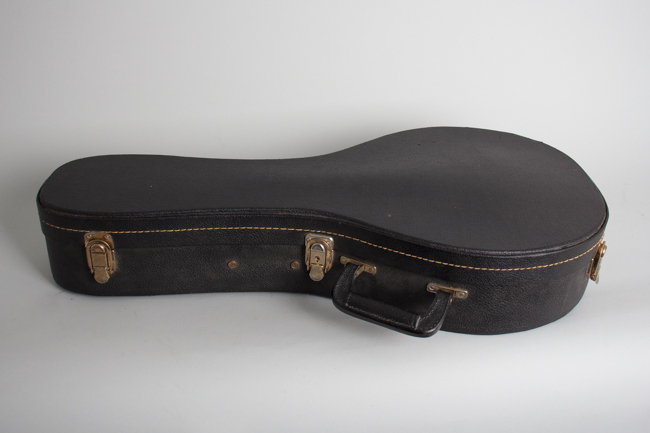Washburn Model 5283 Deluxe Carved Top Mandolin (1935)
This item has been sold.
Item # 10136
Prices subject to change without notice.
Washburn Model 5283 Deluxe Model Carved Top Mandolin (1935), made in Chicago, serial # 407, natural re- finish, maple back and sides, sprice top; Laminared mahogany neck with ebony fingerboard, black tolex hard shell case.
This Washburn-labeled mandolin is a very late production example of the elaborate and beautifully made mandolins Lyon & Healy had originally introduced in 1917. It has been re-worked over the years and is not in fully original condition, but still a very fine mandolin. These Washburns were high-grade instruments, the only really serious competition Gibson ever faced in the carved top 8-string market. Lyon & Healy launched a line of several models in a blaze of publicity in 1917 and they were first cataloged under the "Lyon & Healy Own Make" brand and subsequently as "Washburn" well into the Depression years.
Using the finest materials and a thoroughly original design, Lyon & Healy specifically created these instruments to challenge Gibson in the market for high-end professional mandolins. Before Orville's carved top design was established, Lyon & Healy's bowl backed mandolins were considered the dominant force in the 8-string world. While their own carved-top designs never supplanted Gibson's, L&H did create a timeless classic in this instrument, originally named the Style A. The violin scroll headstock is immediately distinctive, but the 2-point body, shaped pickguard and clamp tailpiece are all signature features.
This example was crafted in the same factory, and by many of the same hands as the 1920s Lyon & Healy instruments but was made and sold by different firms. By 1935 Regal owned and operated the old Lyon & Healy factory in Chicago, having acquired it for pennies on the dollar at the beginning of the depression. Washburn brand instruments were distributed by Tonk Brothers (also of Chicago) at the time; this was one of the few holdovers from the original Lyon & Healy catalog. The design had been slightly simplified by this time, dispensing with a pull-out leg rest that had been mounted in the treble side but otherwise not much changed from the 1920s version.
The sound of these instruments is more delicate and lighter than most Gibsons, with a nicely rounded top end and less "bark". They have been considered since the 1920s to be the best instruments ever made for classical mandolin playing, but have not been much used by old-time or country musicians. We are always impressed by both the sound and craftsmanship of the Lyon & Healy mandolins, even these final Tonk Brothers examples. This Deluxe -- the top of the line model -- has been re-worked over the decades but is still a fine instrument worthy of any player's attention.
Overall length is 24 3/4 in. (62.9 cm.), 9 15/16 in. (25.2 cm.) width, and 1 7/8 in. (4.8 cm.) in depth, measured at side of rim. Scale length is 13 in. (330 mm.). Width of nut is 1 1/8 in. (29 mm.).
This lovely mandolin is more of a player's than collector's example, as it has been noticeably re-worked over the last 8+ decades. It still retains its original character original and is fairly clean overall, but shows evidence of old repair. The entire instrument has an old clear lacquer finish overspray, which has checked noticeably as such jobs tend to do. There is not a lot of subsequent play wear, but some scuffing to the back and dings and chips most noticeably to the headstock and edge of the lower body point. There is a feelable ding in the bass side of the neck by the fourth fret and some chipping along the binding edge.
The most noticeable alteration is the back has been re-bound, in white-black-white celluloid rather than the reverse pattern as was originally used. It actually looks very much like vintage Gibson binding and we wonder if this and the overfinish was actually done at the Gibson factory, an unusual but not unheard of situation for a non-Gibson instrument. At any rare the work is very well done, but does change the look of the instrument somewhat.
The hardware is original and mostly complete; the Vulcanized fiber pickguard is intact as are the carved ebony bridge and inset tuners. The elaborate cover for the clamp tailpiece is long gone; the string clamp itself is intact but shows a lot of corrosion so we assume it has been uncovered for many decades! The frets are small mandolin wire but it does appear the instrument was neatly refretted long ago, with little subsequent wear. The fretboard binding appears to have been reglued in a few spots.
Although carrying a somewhat heavier finish than it did originally this is still a good-sounding instrument, sweet and round toned in the higher register if not as loud as many Gibsons. It plays very well, strung with the Thomastic flatwound strings generally considered the traditional string for these classical-oriented Mandolins. This instrument belonged to the same lady for many decades, and we are told she was a dedicated mandolinist for much of her life and this Washburn was her "Pride and Joy". It resides in a later HSC from the 1970s or '80s. Overall Excellent - Condition.
This Washburn-labeled mandolin is a very late production example of the elaborate and beautifully made mandolins Lyon & Healy had originally introduced in 1917. It has been re-worked over the years and is not in fully original condition, but still a very fine mandolin. These Washburns were high-grade instruments, the only really serious competition Gibson ever faced in the carved top 8-string market. Lyon & Healy launched a line of several models in a blaze of publicity in 1917 and they were first cataloged under the "Lyon & Healy Own Make" brand and subsequently as "Washburn" well into the Depression years.
Using the finest materials and a thoroughly original design, Lyon & Healy specifically created these instruments to challenge Gibson in the market for high-end professional mandolins. Before Orville's carved top design was established, Lyon & Healy's bowl backed mandolins were considered the dominant force in the 8-string world. While their own carved-top designs never supplanted Gibson's, L&H did create a timeless classic in this instrument, originally named the Style A. The violin scroll headstock is immediately distinctive, but the 2-point body, shaped pickguard and clamp tailpiece are all signature features.
This example was crafted in the same factory, and by many of the same hands as the 1920s Lyon & Healy instruments but was made and sold by different firms. By 1935 Regal owned and operated the old Lyon & Healy factory in Chicago, having acquired it for pennies on the dollar at the beginning of the depression. Washburn brand instruments were distributed by Tonk Brothers (also of Chicago) at the time; this was one of the few holdovers from the original Lyon & Healy catalog. The design had been slightly simplified by this time, dispensing with a pull-out leg rest that had been mounted in the treble side but otherwise not much changed from the 1920s version.
The sound of these instruments is more delicate and lighter than most Gibsons, with a nicely rounded top end and less "bark". They have been considered since the 1920s to be the best instruments ever made for classical mandolin playing, but have not been much used by old-time or country musicians. We are always impressed by both the sound and craftsmanship of the Lyon & Healy mandolins, even these final Tonk Brothers examples. This Deluxe -- the top of the line model -- has been re-worked over the decades but is still a fine instrument worthy of any player's attention.
Overall length is 24 3/4 in. (62.9 cm.), 9 15/16 in. (25.2 cm.) width, and 1 7/8 in. (4.8 cm.) in depth, measured at side of rim. Scale length is 13 in. (330 mm.). Width of nut is 1 1/8 in. (29 mm.).
This lovely mandolin is more of a player's than collector's example, as it has been noticeably re-worked over the last 8+ decades. It still retains its original character original and is fairly clean overall, but shows evidence of old repair. The entire instrument has an old clear lacquer finish overspray, which has checked noticeably as such jobs tend to do. There is not a lot of subsequent play wear, but some scuffing to the back and dings and chips most noticeably to the headstock and edge of the lower body point. There is a feelable ding in the bass side of the neck by the fourth fret and some chipping along the binding edge.
The most noticeable alteration is the back has been re-bound, in white-black-white celluloid rather than the reverse pattern as was originally used. It actually looks very much like vintage Gibson binding and we wonder if this and the overfinish was actually done at the Gibson factory, an unusual but not unheard of situation for a non-Gibson instrument. At any rare the work is very well done, but does change the look of the instrument somewhat.
The hardware is original and mostly complete; the Vulcanized fiber pickguard is intact as are the carved ebony bridge and inset tuners. The elaborate cover for the clamp tailpiece is long gone; the string clamp itself is intact but shows a lot of corrosion so we assume it has been uncovered for many decades! The frets are small mandolin wire but it does appear the instrument was neatly refretted long ago, with little subsequent wear. The fretboard binding appears to have been reglued in a few spots.
Although carrying a somewhat heavier finish than it did originally this is still a good-sounding instrument, sweet and round toned in the higher register if not as loud as many Gibsons. It plays very well, strung with the Thomastic flatwound strings generally considered the traditional string for these classical-oriented Mandolins. This instrument belonged to the same lady for many decades, and we are told she was a dedicated mandolinist for much of her life and this Washburn was her "Pride and Joy". It resides in a later HSC from the 1970s or '80s. Overall Excellent - Condition.
